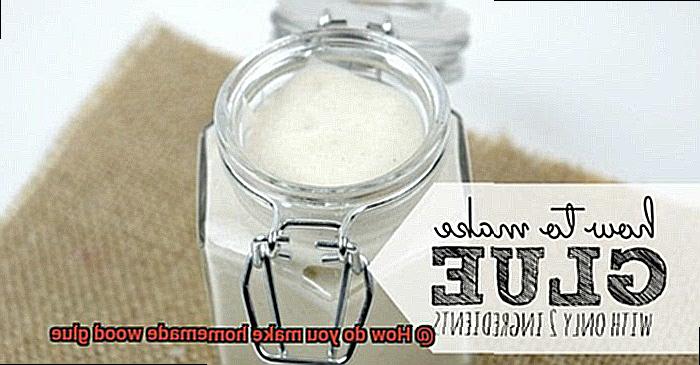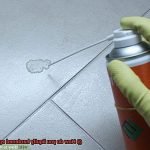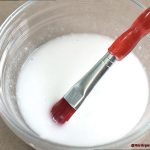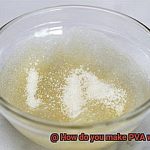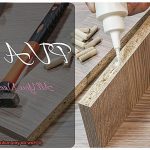Are you tired of spending a fortune on store-bought wood glue for your woodworking projects? Well, have no fear because homemade wood glue is here. With just a few simple ingredients that you probably already have in your pantry, you can create your own cost-effective and eco-friendly glue.
Not only is making your own wood glue a great way to save money and reduce waste, but it’s also a fun and satisfying DIY project. Plus, you can customize the formula to suit your specific needs. Want a stronger glue? Adjust the thickness. Need a certain color? Add natural dyes.
To make homemade wood glue, all you need are some basic supplies like white vinegar, gelatin, and water. The process involves heating up the ingredients together and allowing the mixture to cool and thicken. It’s quick, easy, and perfect for any woodworking enthusiast.
And let’s not forget about the environmental benefits of homemade wood glue. Many commercial glues contain harmful chemicals that can harm both you and the planet. By making your own eco-friendly glue at home, you’re doing your part to reduce your carbon footprint.
So what are you waiting for? Grab your apron and get ready to make some homemade wood glue. We’ve got all the ingredients and step-by-step instructions covered in this post. Trust us – once you try making your own glue, you’ll never go back to buying it from the store again.
What is Homemade Wood Glue?
Contents
- 1 What is Homemade Wood Glue?
- 2 Benefits of Making Homemade Wood Glue
- 3 Ingredients Needed to Make Homemade Wood Glue
- 4 Method 1: Making Homemade Wood Glue Using Milk
- 5 Method 2: Making Homemade Wood Glue Using Flour and Water
- 6 How to Use Homemade Wood Glue for Your Projects
- 7 Tips for Working with Homemade Wood Glue
- 8 Comparison between Commercial and Homemade Wood Glues
- 9 Conclusion
Made from natural ingredients found in most households, this eco-friendly adhesive is an affordable and versatile alternative.
One of the primary advantages of homemade wood glue is its cost-effectiveness. With just a few simple ingredients, you can make your own glue for a fraction of the cost of commercial products. And the best part? You won’t have to worry about exposing yourself or the environment to harmful toxins.
Milk is one of the most common ingredients used in homemade wood glue. This may sound surprising, but milk contains casein protein that can bond with wood to create a strong adhesive. To make this type of glue, heat one cup of milk in a saucepan until it steams, add one tablespoon of white vinegar or lemon juice, and stir for about 10 minutes until it curdles. Then strain out the excess liquid, and you’re left with DIY wood glue that can be used for all sorts of woodworking projects.
Another popular recipe for homemade wood glue involves using flour and water. This method is perfect for creating a thick, paste-like glue that can fill gaps in wooden surfaces. Simply mix equal parts of flour and water in a saucepan and heat the mixture over medium heat until it thickens. Once it cools, you’ll have a versatile adhesive that can be used for everything from repairing furniture to building wooden toys.
While homemade wood glue may not be as strong as commercial options, it’s still an effective adhesive for small woodworking projects. Plus, making your own wood glue saves money and reduces your exposure to harsh chemicals.
Benefits of Making Homemade Wood Glue
It’s time to switch to homemade wood glue. Not only is it cost-effective, but it also offers a range of benefits that make it an eco-friendly and customizable option for DIY enthusiasts.
Let’s start with the cost-effectiveness. Homemade wood glue can be made using readily available ingredients like flour, water, sugar, and vinegar. This means you can save money without compromising on the quality of the adhesive.
Another benefit is customization. You can adjust the thickness, drying time, and strength of the glue to meet your project’s specific needs. Plus, experimenting with different ingredients can help you find the perfect formula for your woodworking needs.
But it’s not just about being cost-effective and customizable. Homemade wood glue is also an eco-friendly alternative to store-bought glues that may contain harmful chemicals. By using natural ingredients, you’re not only saving money but also contributing to a healthier environment.
And let’s not forget about the strength of homemade wood glue. With proper application and curing time, it can be just as effective as store-bought options. You can trust that your woodworking projects will be sturdy and long-lasting.
Last but not least, making homemade wood glue is easy. You don’t need to be an expert to whip up a batch of this adhesive. It’s a straightforward process that requires minimal effort and expertise, making it an ideal option for DIY enthusiasts who prefer to make their own products.
Ingredients Needed to Make Homemade Wood Glue
With just a few simple ingredients that are easy to find, you can create a strong and effective adhesive that will take your DIY game up a notch.
The primary ingredient for making homemade wood glue is water. Boil it to create a hot mixture that serves as the base for the glue. The second key ingredient is gelatin, which acts as a binding agent and can be found at your local grocery store. It’s derived from animal bones, skin, and other connective tissues, making it a sustainable choice.
To preserve the glue and prevent it from going rancid quickly, add vinegar to your mixture. This natural antiseptic also helps to prevent mold growth. For those who prefer a thicker consistency, corn syrup or honey can be added. This helps the glue stick better to surfaces and makes it easier to apply.
For an even more polished finish, consider adding sawdust or sanding dust to create a filler that matches the color of your project’s wood. This will help hide any gaps or cracks in your work and give it a professional touch.
Method 1: Making Homemade Wood Glue Using Milk
Look no further than making homemade wood glue using milk. This centuries-old method is still popular among DIY enthusiasts and woodworkers today, and as an expert in this method, I can attest to its simplicity and cost-effectiveness.
To make your own homemade wood glue using milk, you’ll need skimmed milk, white vinegar, and baking soda. First, heat up the milk and add the vinegar to curdle it, then strain out the liquid whey. Mix the whey with baking soda to create a paste-like glue that can bond different types of wood.
This natural and non-toxic glue dries clear and can be sanded or painted over once it sets. However, it does have a short shelf life and may not be suitable for use in high humidity or wet environments.
To make your homemade wood glue even more effective, try adding sawdust or sanding dust to create a filler that matches your project’s wood color. This will give your project a professional and seamless finish.
Method 2: Making Homemade Wood Glue Using Flour and Water
This tried-and-true method has been used for centuries, and it’s a cost-effective and non-toxic way to make glue that can be used for a variety of woodworking projects.
To make the glue, you’ll need equal parts of flour and water, a saucepan, and some elbow grease. Mix the flour and water in the saucepan, stirring continuously over medium heat until it thickens. Remove the mixture from heat and let it cool down.
The glue can be used immediately or stored in an airtight container for future use. If it becomes too thick after sitting, add more water to thin it out.

While this homemade wood glue may not be as strong as commercial wood glues, it’s still a fantastic option for smaller projects or for those who want to avoid using chemical-based adhesives. Plus, it’s easy to make and won’t break the bank.
It’s important to keep in mind that this glue may not hold up well in humid or wet conditions. So, if you’re working on a project that will be exposed to moisture, commercial wood glue may be a better option.
How to Use Homemade Wood Glue for Your Projects
If you’re looking for a more sustainable and budget-friendly way to glue your woodworking projects together, homemade wood glue might just be the answer. However, there are a few key steps to follow in order to ensure that your project turns out successfully.
Firstly, preparation is key. Make sure that the surfaces you’ll be gluing together are clean, dry, and free from any dust or debris. Sanding the surfaces can also help create a better bond by allowing the glue to penetrate deeper into the wood fibers.
Once the surfaces are prepared, it’s time to apply the homemade wood glue. Use a brush or roller to apply a thin layer of glue to one of the surfaces. Be careful not to apply too much, as this can lead to excess glue seeping out and potentially ruining your project.
After applying the glue, press the two surfaces firmly together and hold them in place for a few minutes. It’s important to use clamps or other tools to keep the surfaces firmly together during this time, as any movement or shifting can weaken the bond.
Once you’ve allowed the glue to dry for the recommended time (which will vary depending on the type of homemade glue used), it’s time to remove any excess glue. This should be done carefully with a damp cloth or sandpaper. It’s important not to wait too long before removing excess glue, as it can become more difficult to remove once it has fully dried.
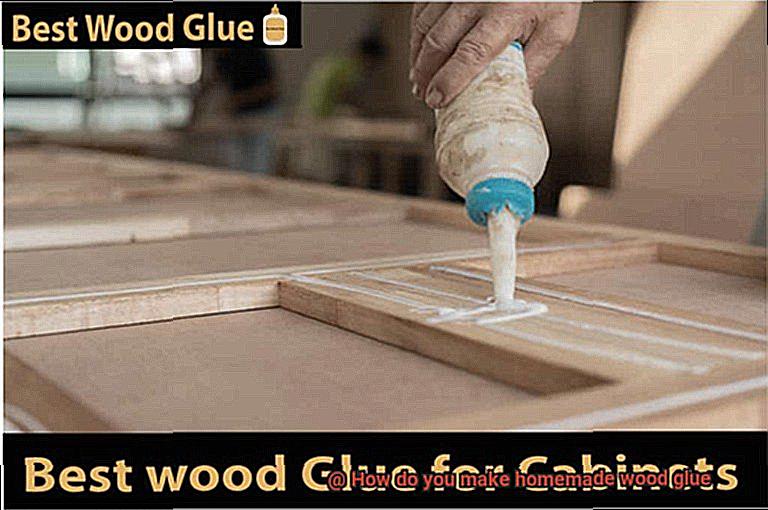
It’s worth noting that homemade wood glue may not have the same strength or durability as store-bought options. Therefore, it’s important to use it for smaller projects that don’t require heavy-duty bonding. However, with proper application and care, homemade wood glue can be an effective and eco-friendly option for DIY projects.
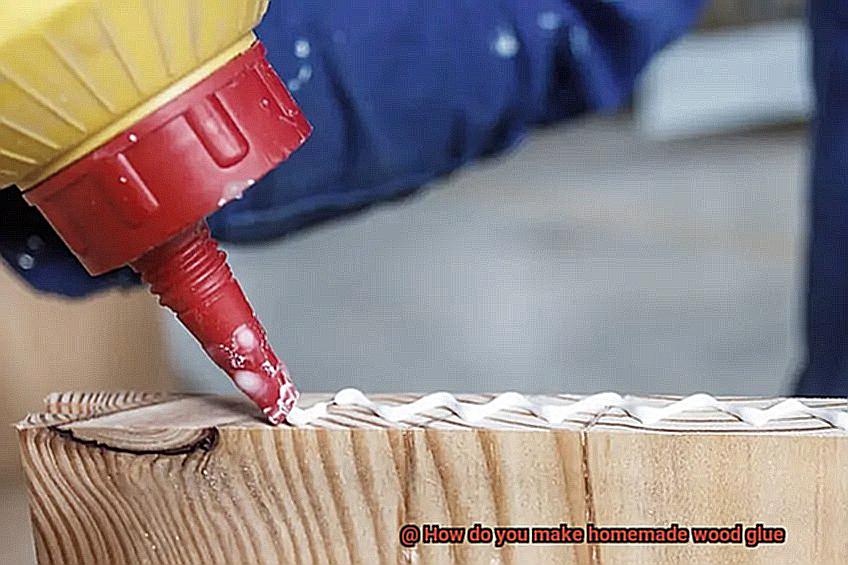
Tips for Working with Homemade Wood Glue
Working with homemade wood glue can be a rewarding and cost-effective option for woodworking projects. However, it’s important to keep in mind that homemade glue may have varying consistency and drying time than store-bought options. Here are some tips and tricks to help you work effectively with homemade wood glue:
Test the Glue
Before using your homemade wood glue on your project, test it out on a small piece of wood. This will help you determine its strength and consistency, and whether any adjustments need to be made to the recipe.
Apply Evenly
Apply the glue in thin, even coats to avoid excess moisture in the wood, which can lead to warping or other issues down the line. Using a brush or roller can help ensure an even application.
Clamp Tightly
Clamping the pieces together after applying the glue will help create a tight bond and prevent movement while drying. Be sure to use enough clamps to keep the wood firmly in place, but not so many that they create pressure points or damage the wood.
Allow Ample Drying Time
Homemade wood glue may take longer to dry than store-bought options, so be patient and give it plenty of time to set. Rushing the drying process can weaken the bond and compromise the integrity of your project.
Store Properly
To prevent spoilage or mold growth, store homemade wood glue in an airtight container in the refrigerator.
Comparison between Commercial and Homemade Wood Glues
When it comes to woodworking, selecting the right glue is paramount for a successful project. Commercial and homemade wood glues are the two main types of adhesives used in woodworking. Commercial wood glues are manufactured using synthetic chemicals, while homemade wood glues can be made using natural ingredients found in most households.
Commercial wood glues come in different forms, including PVA, epoxy, and cyanoacrylate. PVA wood glue is the most commonly used type due to its ability to bond different types of wood and affordability. These glues are readily available in stores and online and are designed to have a strong bonding capability.
On the other hand, homemade wood glues are eco-friendly, non-toxic, and less expensive than commercial wood glues. They are made from natural ingredients such as flour, water, vinegar, and milk. However, they may not be as strong as commercial wood glues and may not hold up well in high-stress situations.
The advantages of commercial wood glues include a stronger bond, versatility, and convenience. Commercial wood glues are designed to have a strong bonding capability and can withstand high-stress situations. They also come in different forms, making them versatile and suitable for different types of woodworking projects. Additionally, commercial wood glues are readily available in stores and online, making them more convenient to use than homemade wood glues.
However, commercial wood glues also have some disadvantages. They contain synthetic chemicals that may be harmful to the environment and human health. Additionally, they can be pricey compared to homemade wood glues.
Homemade wood glues have several advantages as well. They are eco-friendly, non-toxic, and safe to use. Homemade wood glues are also cost-effective since they are made from natural ingredients found in most households. They offer an excellent alternative for those who want to avoid synthetic chemicals found in commercial wood glues.
But homemade wood glues also have some disadvantages. They may not be as strong as commercial wood glues and may not hold up well in high-stress situations. Additionally, homemade wood glues may have different consistency and drying time than store-bought versions, leading to inconsistent quality.
p8ipSODdpuE” >
Also Read: Is there a Mod Podge Alternative? – Glue Things
Conclusion
In conclusion, creating your own wood glue is a smart and savvy choice for any woodworking enthusiast. Not only is it cost-effective and eco-friendly, but it’s also highly customizable to meet your specific project needs. With just a few simple ingredients like white vinegar, gelatin, and water, you can whip up a batch of adhesive that will rival any store-bought option.
The benefits of homemade wood glue are numerous. For one thing, it’s highly cost-effective compared to commercial options. Plus, since you’re making it yourself, you have the ability to tweak the formula to suit your exact requirements. And perhaps most importantly, homemade wood glue doesn’t contain any harmful chemicals or additives that could damage your materials or pose a risk to your health.
When using homemade wood glue on your projects, there are a few key tips to keep in mind. First and foremost, always test the glue on a small piece of scrap wood before committing to using it on your actual project. Additionally, be sure to apply the glue evenly in thin coats and clamp the pieces together tightly while drying. And finally, be patient – homemade wood glue may take longer to dry than commercial options.
All in all, if you’re looking for an effective and sustainable solution for gluing together your woodworking creations without breaking the bank or harming the planet, then homemade wood glue is definitely worth considering.

